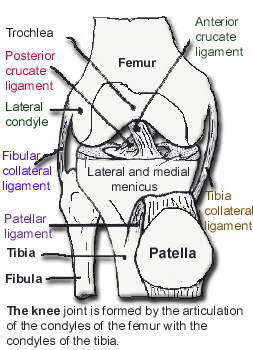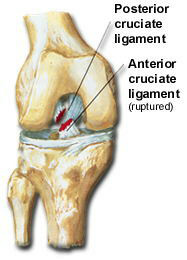ACL Injury
The anterior cruciate ligament (ACL) is important for knee stabilization. This is located deep inside the knee joint.
The ACL helps control how far the tibia can move in relationship to the femur. Injuries to the ACL are very common and most of the time are sports related.
The sports requiring the foot to be planted and the body to change directions rapidly, such as basketball, are associated with a higher incidence of injury. Usually injury will occur to the ACL with a sudden hyperextension or rotational force. Depending on the activity or sport the mechanism may differ somewhat.
Soccer, skiing and football are also three common sports where ACL injuries occur. Often the injured athlete will feel a “pop” in the knee and have sudden pain. The athlete may or may not fall to the ground. Skiers will usually fall. However, a soccer player or basketball player in mid-stride stopping suddenly and pivoting can suffer an ACL tear and still often be able to ambulate.
Besides the pop, the knee often swells after an ACL injury.
It is not uncommon for multiple knee structures to be hurt in an injury. An ACL, MCL and lateral meniscal injury is a common “triad.” Activities requiring rotational motion about the knee, including twisting, cutting and jumping sports, are not recommended after an ACL tear because of the risk of cartilage damage.
The orthopaedic community has realized over the last several years that long term instability of the knee can lead to early arthritis. Some activities, however, can be continued with an ACL lax knee. These are “in-line” sports such as bicycling, light jogging, roller blading and swimming.


